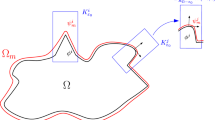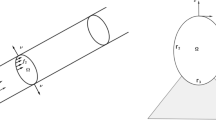Abstract
We study the question whether Lipschitz minimizers of \(\int F(\nabla u)\,dx\) in \(\mathbb {R}^n\) are \(C^1\) when F is strictly convex. Building on work of De Silva–Savin, we confirm the \(C^1\) regularity when \(D^2F\) is positive and bounded away from finitely many points that lie in a 2-plane. We then construct a counterexample in \(\mathbb {R}^4\), where F is strictly convex but \(D^2F\) degenerates on the Clifford torus. Finally we highlight a connection between the case \(n = 3\) and a result of Alexandrov in classical differential geometry, and we make a conjecture about this case.



Similar content being viewed by others
References
Alexandrov, A.D.: On the curvature of surfaces. Vestn. Leningr. Univ. 21(19), 5–11 (1966)
Alexandrov, A.D.: On uniqueness theorem for closed surfaces. Dokl. Akad. Nauk. SSSR 22, 99–102 (1939)
Ambrosio, L., Soner, H.M.: Level set approach to mean curvature flow in arbitrary codimension. J. Differ. Geom. 43, 693–737 (1996)
Araújo, D.J., Teixeira, E.V., Urbano, J.M.: A proof of the \(C^{p^{\prime }}\)-regularity conjecture in the plane. Adv. Math. 316, 541–553 (2017)
Azagra, D., Mudarra, C.: Whitney extension theorems for convex functions of the classes \(C^1\) and \(C^{1,\,\omega }\). Proc. Lond. Math. Soc. 3, 133–158 (2017)
Cohn, H., Kenyon, R., Propp, J.: A variational principle for domino tilings. J. Am. Math. Soc. 14(2), 297–346 (2001)
Colombo, M., Figalli, A.: Regularity results for very degenerate elliptic equations. J. Math. Pures Appl. (9) 101(1), 94–117 (2014)
De Giorgi, E.: Sulla differenziabilità e l’analicità delle estremali degli integrali multipli regolari. Mem. Accad. Sci. Torino cl. Sci. Fis. Fat. Nat. 3, 25–43 (1957)
De Silva, D., Savin, O.: Minimizers of convex functionals arising in random surfaces. Duke Math. J. 151(3), 487–532 (2010)
Delgadino, M.G., Maggi, F., Mihaila, C., Neumayer, N.: Bubbling with \(L^2\)-almost constant mean curvature and an Alexandrov-type theorem for crystals. Arch. Ration. Mech. Anal. 230(3), 1131–1177 (2018)
Evans, L.C.: A new proof of local \(C^{1,\alpha }\) regularity for solutions of certain degenerate elliptic p.d.e. J. Differ. Equ. 45(3), 356–373 (1982)
Evans, L.C., Gariepy, R.F.: Measure Theory and Fine Properties of Functions. Studies in Advanced Mathematics. CRC Press, Boca Raton (1992)
Giaquinta, M.: Growth conditions and regularity, a counterexample. Manuscr. Math. 59, 245–248 (1987)
Gilbarg, D., Trudinger, N.: Elliptic Partial Differential Equations of Second Order. Springer, Berlin (1983)
Iwaniec, T., Manfredi, J.: Regularity of \(p\)-harmonic functions on the plane. Rev. Mat. Iberoam. 5, 1–19 (1989)
Kenyon, R., Okounkov, A., Sheffield, S.: Dimers and amoebae. Ann. of Math. (2) 163(3), 1029–1056 (2006)
Marcellini, P.: Regularity and existence of solutions of elliptic equations with \((p,\, q)\)-growth conditions. J. Differ. Equ. 90, 1–30 (1991)
Marcellini, P.: Regularity for some scalar variational problems under general growth conditions. J. Optim. Theory Appl. 90, 161–181 (1996)
Marcellini, P.: Regularity under general and \(p,\,q\)-growth conditions. Discrete Contin. Dyn. Syst. Ser. S (2019) (to appear)
Martinez-Maure, Y.: Contre-exemple à une caractérisation conjecturée de la sphère. C. R. Acad. Sci. Paris 332, 41–44 (2001)
Martinez-Maure, Y.: New notion of index for hedgehogs of \(\mathbb{R}^3\) and applications. Eur. J. Combin. 31, 1037–1049 (2010)
Mooney, C., Savin, O.: Some singular minimizers in low dimensions in the calculus of variations. Arch. Ration. Mech. Anal. 221, 1–22 (2016)
Morrey, C.B.: Multiple Integrals in the Calculus of Variations. Springer, Heidelberg (1966)
Nash, J.: Continuity of solutions of parabolic and elliptic equations. Am. J. Math. 80, 931–954 (1958)
Panina, G.: New counterexamples to A. D. Alexandrov’s hypothesis. Adv. Geom. 5, 301–317 (2005)
Savin, O.: Small perturbation solutions to elliptic equations. Commun. Partial Differ. Equ. 32(4–6), 557–578 (2007)
Uhlenbeck, K.: Regularity for a class of non-linear elliptic systems. Acta Math. 138, 219–240 (1977)
Ural’tseva, N.: Degenerate quasilinear elliptic systems. Zap. Nauch. Sem. Leningrad. Otdel. Mat. Inst. Steklov 7, 184–222 (1968)
Acknowledgements
The author is grateful to Paolo Marcellini for bringing to his attention some important references on the Lipschitz continuity of minimizers with nonstandard growth conditions. He also thanks the referee for helpful comments that improved the exposition. This research was supported by NSF Grant DMS-1854788.
Author information
Authors and Affiliations
Corresponding author
Additional information
Communicated by C. De Lellis.
Publisher's Note
Springer Nature remains neutral with regard to jurisdictional claims in published maps and institutional affiliations.
Appendix
Appendix
In the Appendix we record some properties of \(\varphi \), and we prove the extension result Lemma 4.1.
1.1 Properties of \(\varphi \)
We recall from [22] that if we parametrize \(\Gamma _1\) by the angle \(\theta \in [\pi /4,\,3\pi /4]\) of its upward unit normal \(\nu \), then its curvature is given by \(\kappa = \frac{\sqrt{2}}{3}\sec (2\theta )\). It follows easily that \(\varphi \) is smooth, even, and uniformly convex on \((-1,\,1)\), and \(\varphi ''\) is increasing on \([0,\,1)\). We recall also the expansion
from [22]. By differentiating implicitly and using that \(\varphi \) is even we obtain near \(s = 1\) the expansions
In particular, for \(0< s < y\) the derivative of the weight \(\varphi ''(s)(y-s)\) is bounded above by \(\varphi '''(s)(1-s) - \varphi ''(s) = -\frac{1}{2}\sqrt{\frac{2}{3}}(1-s)^{-1/2} + O(1) < 0\) for s close to 1.
1.2 Proof of extension lemma
We now prove Lemma 4.1. Our strategy is to first construct G in a set containing a neighborhood of every point on \(\Sigma _0\). We then apply a global \(C^1\) extension result to this local extension. To complete the construction we use a mollification and gluing procedure.
1.2.1 Local extension
Lemma 5.1
There exists an open set \(\mathcal {O}\) containing a neighborhood of each point on \(\Sigma _0\) and a function \(G_0 \in C^{\infty }(\mathcal {O})\) such that \(G_0 = g\) and \(\nabla G_0 = \mathbf{v}\) on \(\Sigma _0\), and furthermore
for all \(p,\,\tilde{p} \in \mathcal {O}\).
Proof
The squared distance function \(d_{\Sigma _v}^2\) from \(\Sigma _v\) is smooth in a neighborhood of each point on \(\Sigma _0\), as is the projection \(\pi _{\Sigma _v}\) to \(\Sigma _v\). Let \(\tau \) be a unit tangent vector field to \(\Sigma _v\) in a neighborhood of a point on \(\Sigma _0\), and \(\nu \) a unit normal vector field. Then \(D^2(d_{\Sigma _v}^2/2)\) projects in the normal direction \(\nu \) on \(\Sigma _0\). See e.g. [3] for proofs of these properties.
Let \(A > 0\) be a smooth function on \(\Sigma _0\) to be chosen, and define
It is elementary to check using (6) that \(\nabla _{\Sigma _0}g\) is the tangential component of \(\mathbf{v}\) on \(\Sigma _0\), and as a consequence that \(G_0 = g,\, \nabla G_0 = \mathbf{v}\) on \(\Sigma _0\). Furthermore, it follows from (6) that \((G_0)_{\tau \tau } \ge 2\gamma \) on \(\Sigma _0\). Since \(D^2(A(\pi _{\Sigma _v}(x))d_{\Sigma _v}^2)\) is 2A times the matrix that projects in the direction \(\nu \) on \(\Sigma _0\), we have that \((G_0)_{\nu \nu } = 2A\) on \(\Sigma _0\), and that \((G_0)_{\tau \nu }\) on \(\Sigma _0\) depends only on \(g,\,\mathbf{v}\), and the geometry of \(\Sigma _0\) (in particular, not on A). By choosing A(p) sufficiently large depending on \(\gamma \) and these quantities (and perhaps going to \(\infty \) as \(p \rightarrow S\)), we have that
on \(\Sigma _0\). In particular, (14) holds in a small neighborhood of each point on \(\Sigma _0\).
Now, for \(\delta ,\,\sigma > 0\) let \(S_{\delta }\) be the closed \(\delta \)-neighborhood of S, and let \(\Sigma _{\sigma }\) be the open \(\sigma \)-neighborhood of \(\Sigma _v\). By (6), (15), and continuity, for each \(\delta > 0\) there exists \(\sigma (\delta ) > 0\) small and an open set \(O_{\delta }\) containing \(\Sigma _{\sigma (\delta )} \backslash S_{\delta }\) and a neighborhood of each point in \(\Sigma _0\), such that (14) holds for all \(p,\,\tilde{p} \in O_{\delta }\) such that at least one of \(p,\,\tilde{p}\) is in \(\Sigma _{\sigma (\delta )} \backslash S_{\delta }\). For \(\delta = 1/k\) we may choose \(\sigma (1/k)\) and \(O_{1/k}\) such that \(\Sigma _{\sigma (1/k)} \backslash S_{1/k} \subset O_{1/k} \subset O_{1/(k-1)}\) for \(k > 1\). Taking
completes the proof. \(\square \)
1.2.2 Global \(C^1\) extension
Lemma 5.2
There exists a \(C^1\) convex function \(G_1\) on \(\mathbb {R}^2\) such that \(G_1 = G_0\) on an open set \(\mathcal {U} \subset \mathcal {O}\) that contains a neighborhood of each point on \(\Sigma _0\), such that \(D^2G_1 \ge \frac{\gamma }{2}I\) on \(\mathbb {R}^2\).
Proof
Let K be a compact set containing \(\Sigma _v\) and a neighborhood of each point on \(\Sigma _0\), such that \(K \backslash S \subset \mathcal {O}\), and \(G_0,\,\nabla G_0\) are continuous up to S in K. Let \(H_0 := G_0 - \frac{\gamma }{4}|x|^2\). On S, define \(H_0 = g - \frac{\gamma }{2},\, \nabla H_0 = \mathbf{v} - \frac{\gamma }{2}x\). Then by (14) we have
for all \(p,\, \tilde{p} \in K\). We may thus apply Theorem 1.10 from [5] to obtain a global \(C^1\), convex function \(H_1\) on \(\mathbb {R}^2\) such that \(H_1 = H_0,\, \nabla H_1 = \nabla H_0\) on K. To finish take \(G_1 = H_1 + \frac{\gamma }{4}|x|^2\). \(\square \)
1.2.3 Smoothing
Lemma 5.3
There exists a convex function \(G \in C^1(\mathbb {R}^2) \cap C^{\infty }(\mathbb {R}^2 \backslash S)\) such that \(G = G_1\) in a neighborhood of each point on \(\Sigma _0\), and \(D^2G \ge \frac{\gamma }{4}I\) on \(\mathbb {R}^2\). In particular, \(D_G = S\), and \((G,\,\nabla G) = (g,\,\mathbf{v})\) on \(\Sigma _v\).
Proof
We begin with a simple observation. Let F be a \(C^1\) convex function on \(\mathbb {R}^n\) with \(D^2F \ge \mu I\). Let \(\rho _{\epsilon }\) be a standard mollifier, and let \(F_{\epsilon } := \rho _{\epsilon } *F\). Then if \(\varphi \in C^{\infty }_0(B_R)\) with \(0 \le \varphi \le 1\) we have
and
Since F is \(C^1\), by taking \(\epsilon (\varphi )\) small we have that \(\varphi F_{\epsilon } + (1-\varphi ) F\) is as close as we like to F in \(C^1(\mathbb {R}^n)\), and we have a lower bound for \(D^2(\varphi F_{\epsilon } + (1-\varphi ) F)\) that is as close as we like to \(\mu I\). We will apply this observation to a sequence of mollifications of \(G_1\).
Let \(\{B_{r_i}(x_i)\}_{i = 1}^{\infty }\) be a Whitney covering of \(\mathbb {R}^2 \backslash \Sigma _v\). That is, for
we have \(r_i = r(x_i)\), the balls \(B_{r_i}(x_i)\) are disjoint, \(\cup _i B_{5r_i}(x_i) = \mathbb {R}^2 \backslash \Sigma _v\), and for each \(x \in \mathbb {R}^2 \backslash \Sigma _v\) the ball \(B_{10r(x)}(x)\) intersects at most \((129)^2\) of the \(\{B_{10r_i}(x_i)\}\). For the existence of such a covering see for example [12].
Now take \(\varphi _i \in C^{\infty }_0(B_{10r_i}(x_i))\) such that \(\varphi _i = 1\) in \(B_{5r_i}(x_i),\, 0 \le \varphi \le 1\). For \(j \ge 1\) we define \(G_{j+1}\) inductively as follows: If \(B_{10r_j}(x_j) \subset \mathcal {U}\) then let \(G_{j+1} = G_j\). If not, then let
with \(\epsilon _j\) chosen so small that
and
By the covering properties, for any \(x \in \mathbb {R}^2 \backslash \Sigma _v\), we have that \(G_j\) are smooth and remain constant in \(B_{10r(x)}(x)\) for all j sufficiently large. In addition, for any point on \(\Sigma _0\), every \(B_{10r_j}(x_j)\) that intersects a small neighborhood of this point is contained in \(\mathcal {U}\), so \(G_j = G_1\) in a small neighborhood of every point in \(\Sigma _0\). We conclude using (16) and (17) that \(G := \lim _{j \rightarrow \infty } G_j\) is \(C^1\), smooth on \(\mathbb {R}^2 \backslash S\), agrees with \(G_1\) in a neighborhood of every point on \(\Sigma _0\), and satisfies
\(\square \)




